
In great dramas, not everything is explained as the story progresses. There may be details in a character’s life that aren’t revealed until a pivotal moment. Till then, the audience has to stretch their own imagination, second-guess what’s going to happen and why. It makes reading, or viewing, fun.
With The Dragon Prince, the showrunners choose to intrigue their viewers, planting seeds within the narrative that won’t blossom till many episodes later. Even in Season Three, which premiered on Netflix November 22nd, some of Season One’s seeds have yet to germinate. For example, we still don’t know the destiny of the Moonshadow elf assassin, Runaan, who got “minted” by the High Archmage, Viren. Or why the mysterious Startouch elf Aaravos got imprisoned behind a magic mirror.
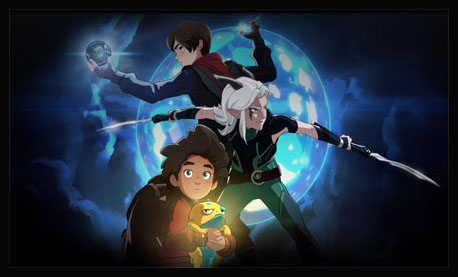
Some questions need answering for the plot to continue. What is the fate of infant Azymondius, the Dragon Prince? Do Rayla the elf warrior and Prince Callum bring him safely to his mother? Are they able to avert a war? What happened to Thunder, the Dragon King? What lies beyond the molten boundary of Xadia? Season Three reveals the answers.
For the unanswered questions, and a glimpse of Season Four, I spoke with the show’s creators, Aaron Ehasz and Justin Richmond of Wonderstorm, who shared their thoughts on November 13th, 2019.
Season One opened with a Moonshadow Elf attack on King Harrow of Katolis—but it was not shown how he died, or who killed him, or even if he died at all. Fans have speculated that the archmage Viren spirited him away with magic.
But, Aaron Ehasz confirms, “Runaan killed him. Runaan of the Moonshadow Elves.”
“At great sacrifice to himself,” Justin Richmond adds.
Meaning, Runaan got turned into a coin by Viren, who did the same to the parents of another prominent character. Can they be restored to their original forms?
Ehasz responds, “My gut is, it seems like the kind of thing that would require incredible and powerful magic to reverse. It was very powerful dark magic that captured and imprisoned them. I don’t even know, can you reverse it without using dark magic? I don’t know if primal magic can reverse it. Those are the kind of questions I would ask myself about, could you reverse it?”
“There’s some stuff in Season Three, if you pay very close attention, you’ll see something right there. I’m not going to point you where,” Richmond says with a chuckle.
“The clue is being dead in the coins. There is a clue at the end of Season Three that answers whether or not they are dead.”
Ehasz says, “We do not answer that question in Season Three. I’m telling you, it would take incredible magic and probably dark magic to reverse it, but I don’t know [if that’s going to happen].”
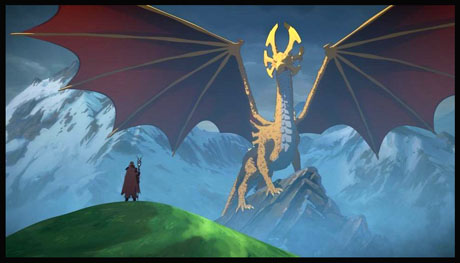
Speaking of dark magic—one of two kinds of magic on the island-continent of Xadia, the other being primal magic—this magic was used to blind Sol Regem, the golden sun dragon, when he threatened to wipe out a human city. The creature has been sightless for centuries, occupying himself with guarding the moonshadow path into East Xadia. Could he be healed?
“I do not think he can be healed by conventional means,” Ehasz replies. “Sun birds were used in dark magic to create that fireball that was searing and dark and awful. That is not a natural burn or a natural scar and it’s something permanent in some ways, right? So there’s not a way through conventional healing magic to restore his sight. If there were, would you go for it? Wouldn’t you find the right mage to fix him up?”
“It’s such a horrible thing that happened to him, but they did try in the past, but, it’s really really bad. That burn’s not coming off that easy,” Richmond says.
“We always called them sun birds. They fly with Sol Regem. They’re in the intro. You see them when they get into the vortex that the dark mage Ziard is doing.”
Ehasz adds, “Sun birds are really connected to the primal and they hang out with the dragon of the sun. That’s really their thing. Obviously he attracts them and they take care of him and they have a symbiotic relationship.”
“They’re more like moray eels,” Richmond says.
“Maybe they pick up little bits of what he’s eating,” Ehasz says.
This raises the question, what does Sol Regem eat? He’s the size of a hill. His daily nutritional requirements must be enormous. Does he somehow—despite his blindness—venture to the ocean and gobble a lot of sea life? Or does he get his energy from the sun? What does he do for nourishment?
“I think he gets something from the sun,” Richmond says. “I don’t know what he eats. Anything he wants, I guess.” He chuckles.
So, it seems Sol Regem abhors the sacrifice of life to empower dark magic—yet life is sacrificed to fill his belly. A dragon with a double standard.
In Season Three, Callum, Rayla and the Dragon Prince escape the dragon’s wrath when his head gets stuck in a stone arch. Being a vindictive fellow, one would assume he’d track down our heroes and avenge his humiliation.
“Well, there is a story there but we’re not going to tell it yet,” Richmond says. “But yes, he breaks out of the arch, for sure. He gets free.”
“There is more Sol Regem to come in Season Four,” Ehasz promises.
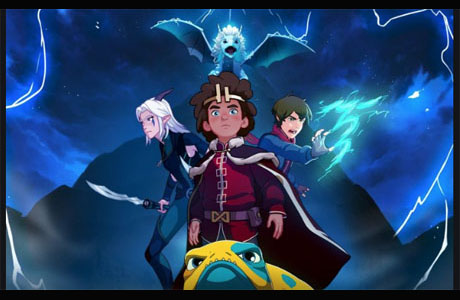
At the end of Season Two, Lord Viren casts a spell that sends shadow assassins into the neighboring kingdoms, to cast blame upon East Xadia and galvanize the humans into fighting the inhabitants of that land.
“They were targeting the kings and queens of the other kingdoms,” Richmond confirms.
Viren’s ex-wife resides in the kingdom of Del Bar. Did she survive?
“Yes,” Richmond says, chuckling. “She’s fine. It was just the leaders.”
Ehasz and Richmond confirm that the shadow assassins dissolved after achieving their mission.
“They are semi-physical, semi-spiritual dark magic manifestations that are part smoke, part spirit. They last through their purpose, and then they expire,” Ehasz says.
Could mages on the human side do nothing to stop them?
“That’s right,” says Richmond.
But Ehasz clarifies: “Not entirely. At least one of the leaders survives, right? King Ahling is hurt but not killed so they maybe half-stopped it. Queen Fareeda manages to live in a story we hope to tell, too. It’s a fun adventure story. She escaped the shadow assassins.”
“There are other mages on the human side. We haven’t talked about them but they do exist,” Richmond reveals.
In Season Three, King Harrow and Lord Viren take on Thunder, the blue sky dragon who killed Queen Sarai—Harrow’s wife—and Duren queens Annika and Neha. Viren turns him to stone—but does that mean he’s really dead?
“He didn’t become a coin. Everything inside him was turned to stone,” Ehasz confirms.
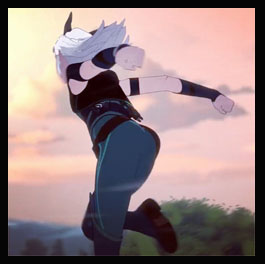
The signature Naruto run
Rayla, the Moonshadow elf warrior, has a signature run inspired by Naruto from the anime of the same name. Curiously, she has a more conventional run when fleeing from Sol Regem. That is, her arms didn’t flail backwards as before.
“In those shots we wanted to make sure she’s really sprinting really really fast, and it was much more readable when she did the classic arm pump. It was a stylistic choice. She’s always run like that. There are other times in the show where she does that,” Richmond points out.
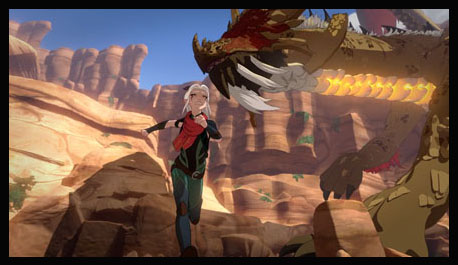
In Season Three, Ezran formally ascends the throne of Katolis, to be forced into making a heart-wrenching choice when the army of Neolandia invades their territory.
“I think a big part of it was that when Ezran was presented with this conflict and this moment, he was not going to see it as a game or a strategy or numbers,” Ehasz explains. “But he has such compassion and empathy, right? It’s part of how he communicates with animals. He’s got truly powerful empathy. If he sees all those numbers as people, and not only as people, but, as people who have relationships and mothers and fathers and friends. He says this out loud. To have that kind of compassion, he asks if he were to sacrifice himself—and he doesn’t come up with the idea; he’s presented that option—would it work? Would the people who did want to fight want to die in a meaningless conflict? Could they be spared? Would he save those people? He decides it’s worth giving up his power to do that, to give them a chance to lose, so that those people won’t die wrongly.
“At the time I was writing that, I was reading through the Chronicles of Narnia with my kids, and I was thinking quite a bit about the scene in The Lion, The Witch and The Wardrobe where Aslan gives himself up and he undergoes humiliation and ultimately, sacrifice. The kids in the story could see Aslan—this great leader—go through this, and he does it because (1. it will stop the battle from happening, and (2. he does it because there’s a deeper magic, that can be seen as metaphorical or whatever. But I think we were inspired partially by that and the kind of leader Ezran is and the kind of selfless sacrifice he would make and he would go through any imprisonment, pain and humiliation to save his people because he’s that compassionate.”
I ask the showrunners if they believed he made the right choice.
“Yes,” Richmond says. “It may not be the perfect choice but it’s the right choice for him at that time.”
Notably in The Dragon Prince, the history of Xadia has been presented by people of dubious character. Aaravos, as narrator in the beginning, tells us that the egg of Thunder was destroyed by the humans—which turns out to be false. Lujanne, the Moonshadow elf mage, deceives with illusions and claims humans cannot perform primal magic—which turns out to be false. Lord Viren, the antagonist of the saga, justifies his actions on historical events.
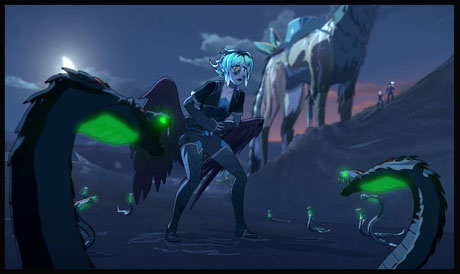
In Season Two, Viren recounts a famine ravaging the neighboring kingdom of Duren, for which the two queens plead for help from the kingdom of Katolis. He doesn’t say whether the other three kingdoms didn’t join the cause of famine relief. He doesn’t explain why they couldn’t feed themselves from seafood since, after all, the continent is an island. He doesn’t give an explanation for not getting food from overseas countries—or is Xadia the only continent on their as-yet-unnamed planet?
Is Viren giving a true history? Can his testimony be trusted?
“Yes, I think it’s accurate,” Ehasz says. “We thought of it as his version of things to influence Queen Aanya but he wasn’t manipulating the facts.”
For The Dragon Prince, Justin Richmond says, “Season Three is the culmination of the first arc that we’ve talked about. It’s the best thing that we’ve done yet.”
Aaron Ehasz adds, “So many people on the team were growing into their full power as storyboard artists, designers, writers, and we’re proud of the work that everyone did on the season and we hope that the community loves it. It’s a culmination, but there’s a deep story in history that has just started to unfold.”
The Dragon Prince, Season Three, premiered November 22nd, 2019 on Netflix. The series is produced by Wonderstorm and animated by Bardel Entertainment.
- INTERVIEW: Aaron Ehasz, Justin Richmond on “The Dragon Prince: Mystery of Aaravos”: The Right Choice for the Voice - March 20, 2024
- INTERVIEW: “The Dragon Prince” Influences, Inspirations, and the Mystery of Simpson - March 11, 2024
- INTERVIEW: The Magic of Her Voice: Paula Burrows of “The Dragon Prince” - October 4, 2023


 November 22nd, 2019
November 22nd, 2019  W.R. Miller
W.R. Miller  Posted in
Posted in  Tags:
Tags: 






